- Read
about the different type of handloom sarees of Odisha, their uniqueness-price
range and see pics.
Orissa
or Odisha is a state located in the east of India, known for its rich and
varied culture. This region has produced many beautiful textiles and gorgeous
handicrafts which are today admired the world over for their complicated
execution and delicate finish.
Orissa sarees are
made using all these beautiful textiles and techniques and are consequently
some of the most pretty and unique sarees in India. They are greatly influenced
by the Jagannath (Hindu deity worshipped in Orissa) culture and frequently
display temple borders, spiritual designs and the traditional colours of
Jagannath.
Heritage of handloom in Odisha
An
Odisha saree can be of many types, depending on the region it is produced in,
the fabric used, the weave of the fabric, the designs on the fabric and the
pallu. Orissa handloom sarees are amongst the finest in the land
since handloom is one of the largest industries in Orissa, not to mention one
of the most ancient.
1. Bomkai or Sonepuri saree
The
handloom artisans here have inherited centuries of knowledge regarding
exquisite weaves and designs and subsequently handloom sarees of Orissa are
amongst the most desirable sarees in the world. Bomkai sari also known as
Sonepuri saree is a handloom drape marked for intricate weaves and patterns.
Another
feature of Orissa or Odisha sarees is the use of exquisite embroidery and
artistic designs, often done on very fine fabrics. The two most popular fabrics
used are silk and cotton. Orissa silk sarees are known for their fine and
lustrous beauty and are frequently worn for special occasions and ceremonies,
while Orissa cotton sarees, though just as colorful and beautiful, are
preferred for more informal occasions because of the high amount of comfort
they offer.
Uniqueness: The most charming part is its thread
work in the designs of the border and the pallu. The appearance of the saree is
related to simplicity and has a tribal tinge in it. The sari is normally dyed
to attain the red, black and white background colours.
Price range: Rs
5000 to Rs 30,000/
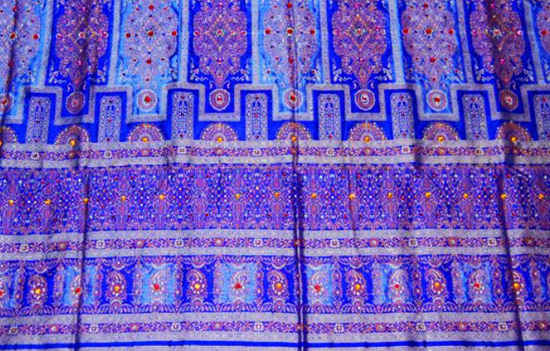
Credits
2. Single Ikat
Single
ikat involves dyeing just the warp or weft threads while in double ikat, both
threads are carefully dyed such that when they come together, they create a
harmonious and beautiful design. Like with all Odisha sarees, silk is the most
popular fabric for ikat sarees though cotton may also be used.
Many
of the regional variations employ the ikat technique in combination with other
crafts to make gorgeous sarees. The Bomkai sarees of Odisha, for instance,
combine the ikat weave with intricate embroidery. The weave and the embroidery
are woven into each other throughout the fabric, while the borders and pallus
often come in bright contrasting colors with intricate thread work. The
embroidered pallus have very aesthetically pleasing designs inspired by tribal
art and often feature natural motifs.
Uniqueness: The unique
characteristic of Ikat fabric is the blurriness of the designs. This blurriness
is a result of the extremely difficult method followed while weaving, as the
weaver lines up the dyed yarns exclusively so that the design patterns are
attained in the most perfect manner on the completed textile. This blurriness
can be reduced either by the skills of craftsperson or by using the finest
yarns. As Ikats are most difficult to create with little blurriness,
complicated
Patterns
using multiple colours, therefore they are more expensive.
Price
Range:
5,000 to 30,000/
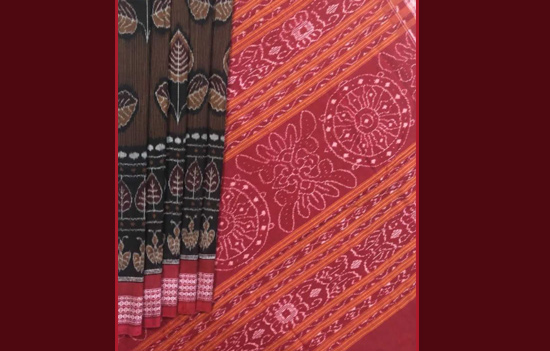
Credits
3. Double ikat weave
The
ikat or double ikat weave is the most famous handicraft of Orissa. This ancient
weave has travelled all over the world, with many other regions having their
own versions. However, the ikat fabrics produced in Odisha are completely
unique, with a fine weave and artistic designs. The ikat technique essentially
involves resist dyeing the threads to create beautiful patterns, before weaving
is done.
Uniqueness: The uniqueness of Double ikat weave lies
is the smoothness and neatness with which it can get the design onto the
fabric.
Price range: Rs 30,000 to Rs 1,00,000/
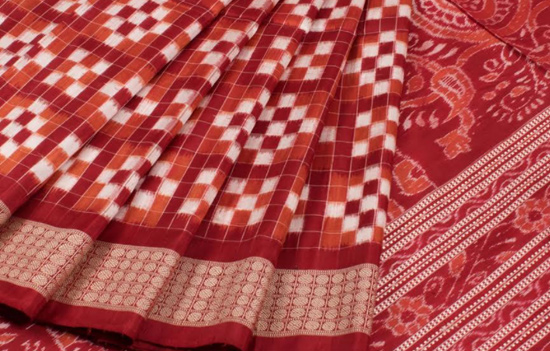
Credits
4. Bandhkala or Baandha
Bandhkala
or Baandha sarees are dyed using the tie and dye method unique to Odisha. They
are very different from Bandhej sarees of Gujarat and Rajasthan and often come
in the traditional colours associated with lord Jagannath: red, white, black
and yellow.
They
have a subtle shimmer as they are interwoven with gold or silver threads. The
artistic dyed designs have a unique three-dimensional beauty. The Sambalpuri
baandha sarees are one of the most stunning Orissa handloom silk sarees, and
come with many symbolic and spiritual motifs on the pallu.
Uniqueness: The highpoint of
these sarees is traditional craftsmanship of the `Bandhakala`, reflected in
their intricate weaves.
1. This was the all-time favourite and highest selling traditional Odisha
Handloom silk saree.
2.
As an Orissa special saree, the speciality of this saree is its geometric
design in the body and touch of traditional culture in the form of different
motifs like Shankha (Shell), Chakra (Wheel), phulla (flower), animals with deep symbolism.
3. The broad border of silk thread work, motif works and completely traditional
aanchal or pallu are the beautiful features of the saree.
4. The uniqueness of this saree is that it's having a traditional border in the middle which makes the saree look awesome.
Price
range:
Rs 3000 to Rs 20000/

Credits
5. Berhampuri Paata
Berhampuri Saree or Berhampuri Patta is a GI product from the Silk City of India, Berhampur in Orissa. Its unique feature is that it comes with a matching ‘joda’ for men. The 200-year old conventional Odisha weaving style is incorporated in its making. The temple or kumbha
design falls into two categories; phoda
or badhi. The zari borders are surely
eye-catching.
The
saree also adorns the three Murtis of the Jagannath temple. They are worn at
weddings and auspicious occasions. It is famous for its temple-shaped designs along
the border and pallu portion. This paata has another distinction: it is draped
around Lord Jagannath, Lord Balabhadra, and Devi Subhadra in Puri Jagannath
temple.
Of
late the weavers are complaining about its bleak
future owing to low wages, shortage of raw material and non-availability of
subsidy in power tariff.
Uniqueness: The Berhampuri
silk saree is unique due to its typical Odissi style of weaving and kumbha,
particularly phoda, temple type design. The zari work border design is
different from others. The weaving technique is said to have originated over
200 years ago. The sarees do adorn the deities of Jagannath, Balabhadra and Subhadra at
the Jagannath temple in Puri.
Price
Range:
3,000 to 30,000/

Credits
6. Khandua Paata
Khandua Sarees (Maniabandi or Kataki), dedicated to Lord Jagannath of Puri Dham, one of the sacred places of India, dates back to the 12th century. In Odia ‘Khandua’ refers to the cloth worn in the lower half of the body. Manufactured in Nuapatna of Cuttack district, a Khandua is rightly termed as ‘Pride of Orissa’.
It is a traditional hand-woven saree woven on wooden looms using pure tussar yarns. It is also popular for its ikat or bandha. It is commonly worn by women during wedding. Kenduli Khandua of 12 feet and 2 Kani (1 kani = length of one’s hand) is engraved with stanzas and illustrations from Gita Govind. It is offered to Jagannath as Khandua.
Uniqueness: The traditional
colours include orange, red and sunset yellow. The borders and pallu are
generally seen in black, blue and red colors. The colors are extracted from Sal
tree. The designs seen on the sarees are auspicious elephants, large many petaled
flowers, a deula kumbha, and a unique Orissan animal Nabagunjara.
It
is lightweight, barely 300 gms and with a comfortable fabric. One type of the
Khandua is the Navakothi which has all the nine main motifs of – flowers, animals, leaves, peacocks, beetel leaves and vessels. Khandua Paata is noted for the texts of Gita Govinda etched on it. Traditionally red or orange in colour, these colours are procured naturally from sal trees. This fabric too, is a registered GI (Geographical Indication) and originated in Cuttack and Maniabandha.
Price
Range:
Rs 5000 to 25,000/
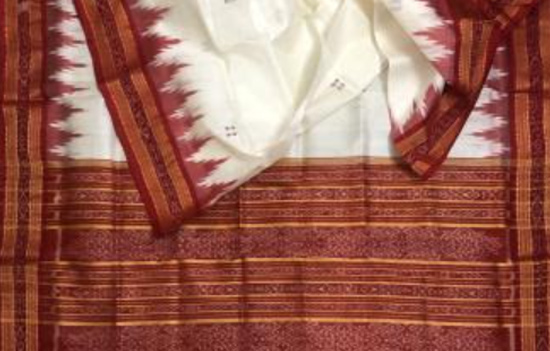
Credits
7. Kotpad
Kotpad
Sarees are vegetable-dyed fabric weaved by the tribal Mirgan community of
Kotpad village in the Koraput district of Orissa. Out of the several Orissa
sarees, these received the first GI mark. These are usually cotton sarees with
solid borders and pata anchal. The ingredients for the rich textures are aul
(madder) tree roots, tussar silk, and cotton yarns. Even though they have
limited shades of color (black and maroon being the most common), they are
eco-friendly, pleasant and shining.
They
are also comfortable to wear during summers and winters. The motifs developed
by the extra weft are axe, crab, bow, fish, temple, fan, conch and boat,
reflect the culture of the sea. The sarees have befitting elaborate borders and
designs depending on the occasion.
Uniqueness: Kotpad Handloom
is a vegetable-dyed fabric woven by the tribal weavers of the Mirgan community
of Kotpad village in Koraput district, Odisha, India. These beautiful
organic cotton sarees are adorned with intricate tribal art motifs.
Kotpad sarees blend excellent colours and soft fabric, which give a heavenly
feeling to the skin of the wearer, besides making her look absolutely
stunning. Sarees and shawls are
the most important and attractive textile products from the Kotpad weaving
community. The textiles are very comfortable to wear during summer and winter.
Price
Range:
Rs 3000 to 20,000/
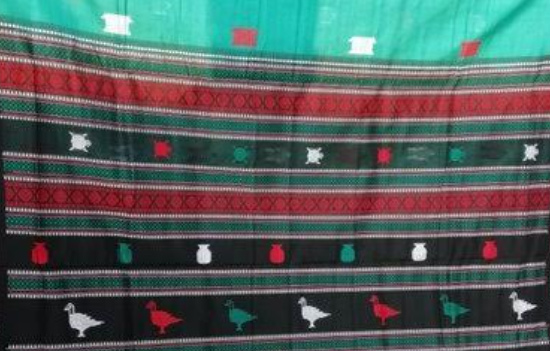
Credits
8. Habaspuri
Habaspuri
Saree is a GI marked tribal handloom product from Orissa. The kondha weavers
from Chicheguda, Kalahandi district are attributed to the weaving of this
exquisite piece. It has taken its name from the Habaspur village where it was
originally woven during the 19th century.
The
making of a Habaspuri is a time-consuming and painstaking process. The traditional
patterns in Kumbha style are etched out on the saree. It is basically a cotton
saree. The weavers are trying hard to restore the dying art of this saree in
the best possible ways.
Uniqueness: The Kondha weavers
of Chicheguda, Kalahandi district, Odisha are originally
attributed for weaving of the Habaspuri fabric. For its uniqueness in
weaving, design and production, it has been identified as one of the 14 Geographical Indications of Odisha.
The textile has traditional patterns of the region
like kumbha (temple), fish and flowers.
Price
Range:
4500 to 11,000/
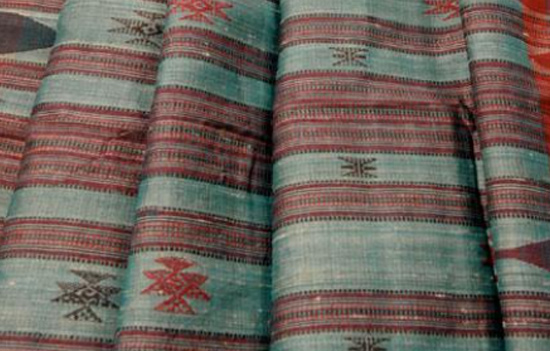
Credits
9. Saktapar/Pasapali
Pasapali or Saktapar Sarees are one variant of the Sambalpuri sarees of Orissa. They are mainly weaved in the Bargarh district. ’Pasapali’ comes from the word ‘pasa’ meaning chess or gambling games using a chessboard. Hence, they have
detailed chequered patterns of different variety and color combinations.
They
are identified by the double ikat weave in the pattern of a chessboard and
brocaded borders. Their unique symmetry makes them stand out in ethnic Indian
fashion wear for women. Tussar, silk, pure organic cotton and their varied
combinations serve as the base material for the fabric.
Pure
silk threads are then woven to enhance its glossy appearance. The anchal or the
pallu has motifs like conch, flowers, animals, birds, temple, wheel and
landscape.
Uniqueness: Check Patterns and a Medley of Motifs
Known for their exquisite pallus, these
hand-woven drapes are tastefully styled with white and black/red squares and varied
motifs. The yarn is first tied and dyed with natural colours and then hand
woven with rich depictions of shell, flowers, wheels, landscapes and geometric
patterns. While the use of golden threads lends a hint of shimmer, the baandha
or tie and dye is performed in a manner that ensures the motifs appear same on
both sides of the saree.
Arty Evening Wear: Intricate craftsmanship
and weaving techniques make these drapes perfect for a beautiful evening wear.
Price
Range:
Rs 5000 to Rs 25,000/
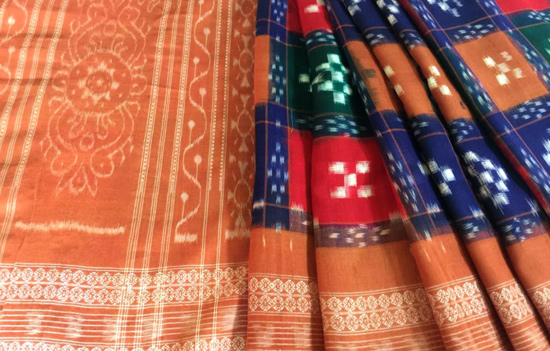
Credits
10. Dongria
Dongria
Sarees are inspired by Dongria or the tribal art form of Orissa. They are woven
the Dongria Kondh tribe of the Munda ethnic group, located in the Niyamgiri
Hills from the districts of Rayagada and Kalahandi. They are handwoven pure
soft cotton fabric. Natural products like dyes and cotton yarns make them
eco-friendly.
They
are rare and unique. They are generally thick weaves with bright and vibrant
color play and geometric and simple designs. Today to catch up with changing
times there are prints and modern textures and designs.
Uniqueness: Dongria silk
saree is different & unique from other handlooms. Red, green, orange &
yellow colours are inspired truly from mother earth are beautifully woven into
distinct geometric patterns. As this fabric is eco-friendly so all nature
lovers grab it to your wardrobe to speak the language of beauty,
sincerity & boldness. The exquisite & unique piece of saree woven
by Dongria Kandh of Kalahandi & Rayagada district in the state of
Odisha. These sarees are made out of rare textiles like course organic cotton.
This ethnic piece gives you protection from the cold.
Price
range:
Rs 2500 to Rs 15,000/
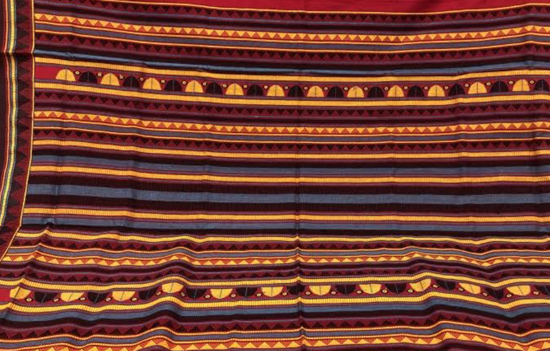
Credits
11. Gamucha
(Special Mention)
Gamchha is a traditional Indian towel made up of thin coarse cotton fabric. Although it is normally used for drying one’s body after bathing, gamcha serves other purposes also. It forms an important item of men’s clothing, especially of those belonging to the lower sections of the Indian society. For instance, one often sees those doing physical work like coolies, construction workers and farmers, carrying a gamcha on their shoulders.
Farmers
keep the gamchha on their shoulders to wipe away the sweat while toiling in the
scorching sun, the whole day long. Sometimes, they also spread it out on the
ground like a mat and take a nap on it. In ancient India, travellers used the
gamocha to carry food in it while journeying. It also forms one of the
essential items offered to Indian deities during religious ceremonies.
Price
range:
Rs 150- Rs 500/
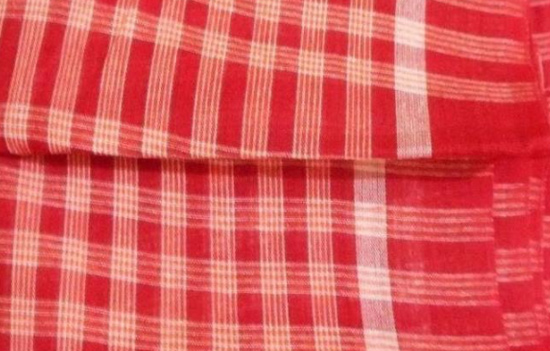
Credits
Styling the heritage Odisha sarees
One
of the best things about the ethnic fashion revival in India and its subsequent
international popularity is that many of the lost or dying arts of India
received a much wider customer base. Orissa sarees have also benefited from
this new focus and many of the gorgeous Orissa handloom silk sarees are spotted
at red carpets and on fashion runways.
Today,
they come in a much wider range of colours and designs so as to appeal to a
wider customer base. There are so many different varieties of Orissa sarees
that women can easily dress up in them for formal, informal or office events.
The
Orissa silk saree woven with subtle but attractive Ikat designs is the perfect
outfit for a daytime soiree for which formal dressing is required. Though light
and fine-looking, they can be accessorized with appropriate jewellery like gold
necklaces and silk clutches to add the formal touch.
For daily wear, women can opt for Orissa sarees with price tags that won’t burn a hole in the pocket, such as simple Baandha cotton sarees. An Orissa cotton saree embroidered with spiritual designs is also a comfortable and attractive option for ceremonies and festivals where traditional dressing is required. They can be accessorized with off-beat Indian jewellery like wooden bangles and terracotta necklaces to emphasize on the ethnic element.
Best Places to buy Odissi Sarees (eSamskriti is not responsible or liable for what you buy from any of these sites).
https://www.boyanika.com/
https://www.saree.com/handloom-sarees-from-odisha
https://utkalamrita.com/
https://www.orissahandloom.com/
https://gocoop.com/
https://suta.in/blogs/saree-diaries/physical-saree-shops-in-india
https://traveltriangle.com/blog/shopping-in-bhubaneswar/
https://mycitylinks.in/9-pretty-sarees-from-odisha-that-every-woman-should-be-proud-to-possess/
https://www.itokri.com/collections/sarees
https://www.sanskriticuttack.com/
To read all
articles by author
Author Trishna Patnaik is a self-taught artist based in Mumbai, Trishna has been practising art for over 14 years. She is now a full-time professional painter pursuing her passion to create and explore to the fullest. She conducts painting workshops across India. She is also an art therapist and healer who works with clients on a one to one basis. Not to forget her quality writings on Indian Art and now Textiles for esamskriti. She fancies the art of creative writing.
The purpose of this compilation is to document and promote. We have given credits and reference links in this compilation along with third party links (to promote). In case some are missed, it is not with malafide intent. Please email full details to esamskriti108@gmail.com
and we shall effect the change.
Also see pictures of
1.Sualkuchi Saris Assam
2. Paitani Sarees Maharashtra
3. Crafts Odisha.
4. Maheshwari Sarees, M.P.
5. Bhujodi Weaving Kutch
6. Textiles and Handlooms Manipur
7. Women Textiles Cooperative Tripura
8. SADHANA Udaipur
9. Chanderi Saris - their rich history